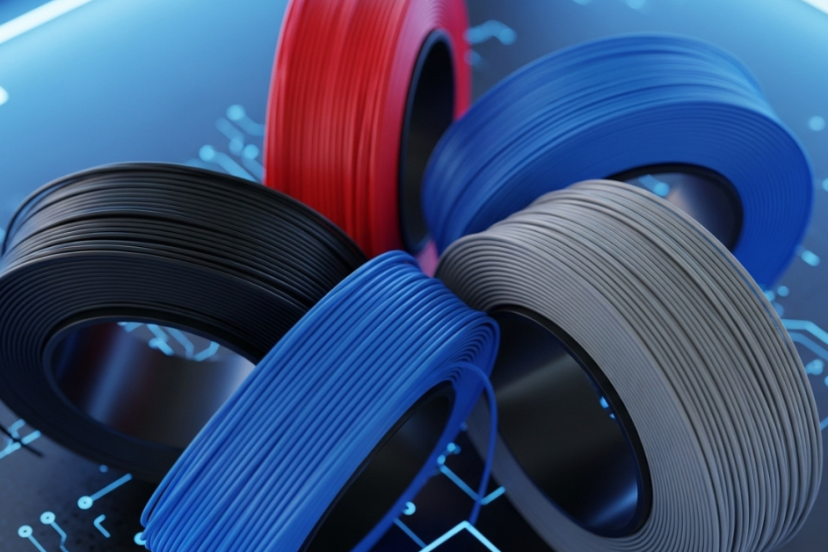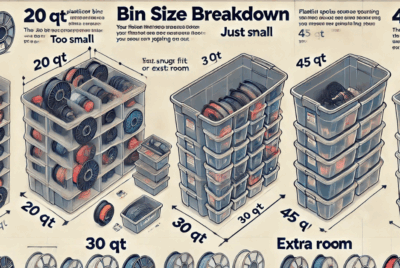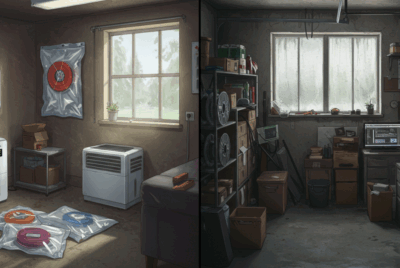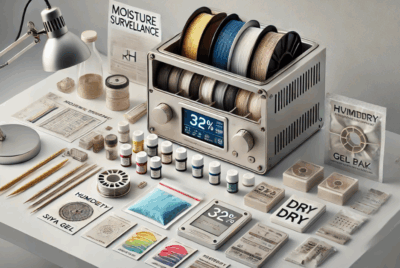Top 10 ABS Plastic Rolls for 3D Printers: 2024 Edition
Hey, fellow 3D printing enthusiasts! It’s a fantastic time to be alive, isn’t it? Remember when 3D printing was just a futuristic dream? Today, it’s our reality, and the heart of that reality is the filament we choose. Have you ever wondered why so many people rave about ABS plastic rolls for their printers? 🤔 Let’s dive right in!
Why ABS for 3D Printing?
Ever thought of 3D printing as cooking? Imagine your printer is an oven, and the filament is your main ingredient. You wouldn’t want to compromise on that primary ingredient, would you? Here’s why ABS is that star ingredient for many printing chefs out there.
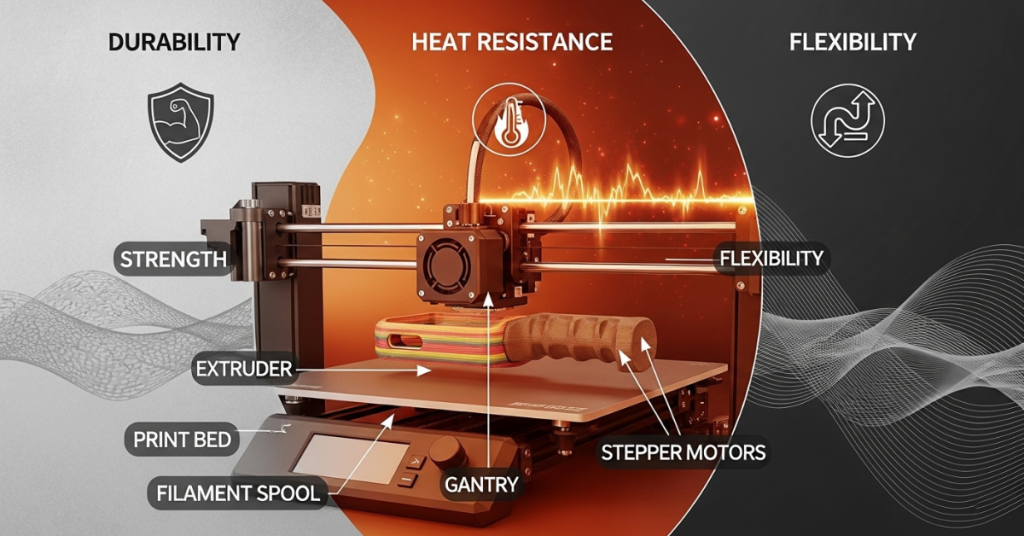
Durability: The Superhero Trait
ABS isn’t just strong; it’s resilient. This filament can withstand a good deal of physical stress, making it ideal for objects that need to take a bit of a beating. Whether it’s a phone case, a tool handle, or a part for your DIY project – with ABS, you’re looking at a lifespan that might surprise you. How many times have you wished for things to last a little longer?
Flexibility: Bend, Don’t Break
While materials like PLA are more rigid, ABS has a slight flex. This means that under pressure, instead of snapping or shattering, it’ll bend a little. Think of it like a gymnast: strong and flexible. How cool is it to print something that can move with the rhythm of your life?
Heat Resistance: Sunbathing Without the Tan
Summer’s here, and while you’re worried about your ice cream melting, with ABS, you won’t have to worry about your prints. ABS can resist higher temperatures than some other common filaments. So, those custom-made car accessories? They’ll be sunbathing without a worry!
Affordability: Quality Without the Price Tag
We all love a good bargain, right? ABS manages to strike a delicate balance: it offers premium quality prints without making your wallet cry. In the 3D printing world, it’s like finding a designer dress at a thrift shop price. Who can resist?
Finishing Options: A Smooth Operator
Ever had a print that just looked a bit… rough around the edges? ABS can be smoothed with acetone, giving it a polished, professional finish. Imagine the possibilities! Sleek designs, smoother textures, and an overall aesthetic that screams ‘top-shelf’.
With all these benefits packed into one filament, it’s no wonder ABS is a darling of the 3D printing community. Still, every filament has its place, and ABS shines bright where strength, flexibility, and heat resistance are paramount. Ready to give your prints the ABS advantage? 🌟
Top 10 ABS Plastic Rolls for 2024
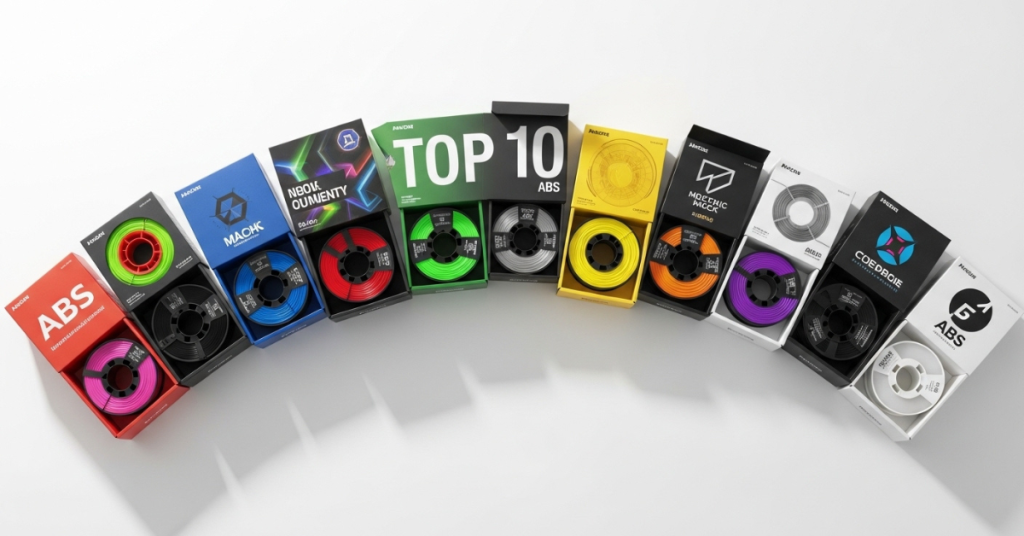
As we journey into the world of 3D printing, knowing your filaments can be the difference between a “meh” print and a “wow” creation. Here’s our deep dive into the crème de la crème of ABS rolls this year:
Polymaker ABS Filament:
Specifically the PolyLite ABS, is highly regarded for several key reasons, making it a preferred choice for various 3D printing applications:
- Quality and Reliability: Manufactured by Polymaker, the PolyLite ABS is made with a special bulk-polymerized ABS resin. This type of resin has a significantly lower volatile content compared to traditional ABS resins, ensuring reliable print results and excellent printing quality. The lower volatile content also results in minimal odors during the printing process, which is a significant advantage over other ABS filaments.
- High Impact Resistance and Temperature Resistance: ABS (Acrylonitrile Butadiene Styrene) is known for its toughness and impact resistance. PolyLite ABS retains these properties, making it suitable for applications requiring durability and the ability to withstand mechanical stress. Additionally, it has high-temperature resistance compared to other common 3D printing materials like PLA, making it ideal for functional parts exposed to elevated temperatures.
- Compatibility and Post-Processing: Polymaker’s PolyLite ABS filament is designed to be compatible with a wide range of 3D printers supporting ABS material. This broad compatibility with FDM/FFF (Fused Deposition Modeling/Fused Filament Fabrication) 3D printers is a significant advantage. Furthermore, ABS filaments, including PolyLite, can be post-processed using techniques like acetone vapor smoothing, resulting in a smoother and more polished surface finish.
- Printing and Drying Settings: The recommended printing temperature for PolyLite ABS is between 245˚C – 265˚C, with a bed temperature of 90˚C – 100˚C. These settings, along with proper bed adhesion techniques, can help in printing larger parts without deformation or warping issues. For drying, the settings are 70˚C for 6 hours, applicable if the material has absorbed moisture.
- Spool Options and Availability: PolyLite ABS filament is available in various spool sizes, including 0.5kg, 0.75kg, 1kg, 2kg, 3kg, and even a 5kg plastic spool. These options provide flexibility depending on the scale of the project and the volume of filament needed.
The Polymaker PolyLite ABS filament stands out for its quality, impact and temperature resistance, wide compatibility with 3D printers, the potential for smooth post-processed finishes, and the variety of spool sizes available. These attributes make it a top choice for users looking for reliable and high-quality ABS filament for their 3D printing needs.
The Hatchbox ABS 3D Printer Filament:
Is widely appreciated for its high quality and durability, making it a popular choice in the 3D printing community. Here are several reasons why this filament is highly regarded and best suited for certain applications:
- High-Quality and Precision: Hatchbox ABS is known for its exceptional quality. It boasts a precision of plus or minus 0.03 mm in its filament diameter, ensuring consistent results in 3D printing.
- Durability and Thermal Resistance: This filament is celebrated for its toughness and durability. It is also thermally resistant, which makes it suitable for applications that demand these qualities. Its ability to withstand higher temperatures than PLA (a common 3D printing material) extends its usability to a broader range of applications.
- Versatility and Finish: Hatchbox ABS is versatile in terms of the range of applications it can support. It offers a glossy finish and can be used for functional production models, making it suitable for both prototypes and end-use applications.
- Beginner-Friendly and Expert-Approved: While it can be slightly challenging to use due to its sensitivity to changes in settings and its proneness to warping, once optimized, it delivers excellent results with a glossy and smooth finish. This balance makes it suitable for both novice and experienced users.
- Packaging and Storage: The filament comes well-packaged in a recyclable cardboard box, with a resealable bag and desiccant pouch for safe storage between uses, ensuring the longevity and quality of the filament.
- Color Variety and Formats: It is available in a large variety of colors and in two different formats (1.75-mm and 3-mm), catering to different printing requirements and aesthetic preferences.
However, there are a few considerations to keep in mind:
- Sensitivity to Settings: Hatchbox ABS can be sensitive to changes in printing settings, such as temperature and cooling, and may require time to tune these settings for optimal results.
- Warping and Adhesion Issues: Users may encounter issues with bed adhesion and warping, although these can be mitigated with additional adhesives and modifications to the printing environment.
- Color Accuracy and Temperament: While offering a wide range of colors, the color accuracy may vary. Additionally, it can be more temperamental compared to other ABS filaments, which may require some adjustments for optimal print quality.
In summary, Hatchbox ABS 3D Printer Filament stands out for its high-quality, durability, and versatility, making it a good choice for both beginners and experts in 3D printing. However, it does require careful tuning and handling to achieve the best reslts.
Overture ABS Filament:
Is a popular choice among 3D printing enthusiasts for several reasons. Let’s explore why it’s loved and what it’s best for:
- Quality and Performance: Overture ABS is known for delivering outstanding print quality. It features low warping and minimal odors, which are common issues with ABS filaments. This makes it a reliable choice for various 3D printing projects.
- Affordability: Despite its high quality, Overture ABS is reasonably priced. A spool of Overture ABS costs around $20, making it an affordable option without compromising on print quality.
- Print Parameters: For optimal results, Overture ABS should be printed with a nozzle temperature of 245°C to 265°C and a bed temperature of 80°C to 100°C. These settings help in achieving the best layer adhesion and overall print quality.
- Environmental Consideration: Overture is transitioning to reinforced cardboard spools, which is a step towards environmental sustainability.
- Color Range and Packaging: Although it has a limited color selection (white, black, red, gray, and blue), each spool is vacuum-sealed to keep the filament moisture-free, which is crucial for maintaining its quality.
- Compatibility: Overture ABS is compatible with most 3D printers and has a standard 1.75 mm diameter, making it a versatile choice for various printing needs.
- Use Cases: It’s ideal for printing items that require durability and resistance to higher temperatures. However, it’s important to note that ABS is not as suitable for items that require biodegradability or are exposed to high moisture levels.
Overture ABS Filament stands out for its quality, affordability, and compatibility with most 3D printers. It’s a great choice for users looking for reliable ABS filament for a range of applications, especially where durability and heat resistance are required.
The Sunlu ABS Filament:
Is highly regarded for several reasons:
- Humidity Resistance: It is treated to minimize the effects of humidity, ensuring consistent print quality regardless of environmental conditions.
- Low-Temperature Printing: This filament requires lower printing temperatures (225-235℃) than regular ABS filaments, which saves energy, reduces costs, and minimizes wear and tear on printers and materials.
- Quality and Consistency: Manufactured with strict standards, it offers consistent wire diameter, ensuring more accurate and consistent prints.
- Low Shrinkage and No Cracking: It has low shrinkage, resulting in more accurate rendering of design details, and offers strong adhesion without warping, preventing print failures.
- High Compatibility: Compatible with 99% of 3D printers and 3D pens, making it versatile for various models and brands.
- Durability: Known for high strength and good toughness, it produces durable prints.
- Affordability: Offers a great combination of quality and performance at an affordable price, making it suitable for both beginners and experienced users.
These features make Sunlu ABS Filament a top choice for a wide range of 3D printing applications, from personal projects to intricate commercial models.
The eSUN 1.75 Gray ABS+ filament:
Offers several notable features and advantages, making it a popular choice for 3D printing enthusiasts.
Key features include:
Robustness and Durability: This filament is designed to produce robust and durable models, suitable for objects that require strength and longevity.
High Toughness and Impact Resistance: It boasts high toughness and impact resistance, making it ideal for functional parts that might experience stress or impact.
- Ease of Printing: Users appreciate its ease of printing, which is a significant advantage over some other filaments that can be more challenging to work with.
- Low Odour: The filament emits a low odour during printing, making it more pleasant to use, especially
in enclosed spaces or for prolonged periods. - Low Shrinkage: Compared to traditional ABS filaments, eSUN ABS+ has lower shrinkage, which helps in maintaining the dimensions and shape of the printed object.
However, it’s important to note that despite these advantages, there are some considerations to keep in mind. ABS+ tends to shrink, so constant temperatures during printing are crucial, and it’s recommended to print in a closed chamber.
While the filament generally receives positive feedback for its mechanical properties and print quality, some users have reported issues with the spool quality. For instance, one user expressed disappointment upon receiving a cardboard spool that was poorly wound, leading to frequent jams and warping in their prints.
These aspects collectively contribute to why many users love eSUN 1.75 Gray ABS+ for its printability and the quality of the final printed objects, especially for applications where durability and strength are important. However, the occasional issues with spool quality highlight the importance of ensuring proper storage and handling of the filament for optimal results.

Amazon Basics ABS Filament:
It’s designed to fit most common 3D printers, with a 1.75mm diameter and a 1 kg spool. The filament is made of ABS, a strong thermoplastic material suitable for creating durable items that need to resist heat. It’s engineered to reduce jamming and comes with a 1-year limited warranty from Amazon Basics.
However, user reviews indicate some challenges:
- A user who typically uses Overture and Hatchbox ABS filaments reported difficulties with the first layer adhesion and temperature regulation when using Amazon Basics ABS. They switched back to their usual filament without issues, suggesting that the problem was specific to the Amazon Basics product.
- Another review mentioned that this filament is not pure ABS but a compound, resulting in high shrinkage and requiring more flow time than regular ABS. The user faced difficulties with grip and layer adhesion, ultimately giving up on the product.
- A user spent a week adjusting their printer settings for this filament but encountered problems with warping, sticking plates, and layers. They found that heating the filament to 270 degrees and reducing print speed improved layer adhesion, but most prints still failed.
The Amazon Basics PLA and PETG filaments received positive reviews for their quality and ease of use. Both filaments were able to capture small features and had a good glossy surface finish. The PLA is best suited for prototyping, toys, and figurines, while the PETG offers higher rigidity and chemical resistance, making it suitable for more functional usage. The materials were found to be good value for money at $19 per 1kg spool.
Based on the general properties of ABS filament, it’s typically favored for its strength, durability, and higher resistance to heat, making it suitable for functional parts and objects that might experience higher stress or temperatures.
Creality ABS Filament:
Is highly regarded in the 3D printing community for several reasons:
- Durability and Impact Resistance: Creality ABS Filament is known for its great durability and impact resistance, which makes it a popular choice for industrial 3D printing applications. It was one of the first filaments to be used in industrial 3D printers due to its high-performance characteristics.
- Material Properties: This filament offers good strength and abrasion resistance. It is also noted for its softness and excellent heat resistance, which allows for very fast printing speeds. However, it requires a higher printing temperature (210-240°C) and may deform after cooling.
- Ease of Post-Processing: ABS is one of the most popular 3D printing materials partly due to its ease of post-processing. It has good mechanical properties and heat resistance, making it suitable for a variety of applications. ABS is more heat resistant and durable than PLA, another common 3D printing material.
- Quality and Compatibility: The Creality ABS Filament is made with 100% virgin material, ensuring strength, durability, and a bubble-free and dirt-free print. It’s compatible with most FDM printers and is known for its smooth printing performance, especially for large objects with edges and corners. The filament has strong fluidity, which helps in reducing cracking or warping in the final print.
- User-Friendly Design: Designed for ease of use, the Creality ABS Filament is user-friendly and compatible with a wide range of FDM printers in the 3D market. This makes it a versatile option for various 3D printing projects.
- Technical Specifications: The filament has a diameter of 1.75mm, a weight of 1Kg spool, and a precise dimensional tolerance of +/- 0.03 mm. For optimal results, a printing temperature between 220-260°C is recommended. Each spool is vacuum packed with desiccant for moisture protection. Additionally, it features low warping and extrusion temperature properties, ensuring better adhesion to the build plate and lower smoke and odour levels during printing.
In summary, Creality ABS Filament is favored for its balance of strength, durability, heat resistance, and ease of use, making it suitable for a wide range of 3D printing applications. Its compatibility with various printers and its high-quality make it an ideal choice for both hobbyist and professional use.
The NovaMaker Black ABS Filament:
Is a highly regarded option in the realm of 3D printing materials, especially for users seeking a strong, durable filament with specific advantages. Here’s a detailed overview of its features, advantages, and applications:
Features and Specifications:
- Material Composition: The NovaMaker Black ABS Filament is made with a specialty bulk-polymerized ABS resin, which results in lower volatile content compared to traditional ABS resins.
- Dimensional Accuracy: It boasts a dimensional accuracy of +/- 0.03 mm, ensuring consistent print quality.
- Diameter and Spool Size: The filament has a diameter of 1.75mm and comes in a 1kg spool.
- Printing Temperature: It is suitable for 3D printing at temperatures ranging from 230°C to 260°C.
Advantages:
- Less Odor and Warping: The filament is designed to produce less odor and is less prone to warping, a common issue with ABS materials.
- Strength and Durability: Parts printed with NovaMaker ABS are noted to be more flexible and less brittle than those made with PLA filament. This makes it ideal for ‘wear and tear’ prints.
- High-Temperature Resistance: Its high resistance to heat makes it superior to PLA for objects that are exposed to sun or high temperatures.
- Dimensional Consistency: The filament maintains consistent size throughout the printing process, reducing issues like knotting and tangling.
Practical Applications and User Experience:
- Better for Practical 3D Prints: ABS is generally tougher than PLA and is preferred for objects that require longevity and strength, such as fixtures or parts of furniture.
- Vapor Smoothing Capability: ABS allows for acetone vapor smoothing, a process that can give printed objects a professional-looking finish.
- Suitability for Complex Shapes: It performs well in bridging and complex shapes due to its rapid cooling properties.
Considerations:
- Ventilation Needs: ABS produces fumes that can be toxic, so it is important to use it in a well-ventilated area.
- Warping and Adhesion: To prevent warping and adhesion issues, it is advisable to use a heated bed and enclosed printing environment.
- Environmental Concerns: ABS is not biodegradable, which is a factor to consider in terms of environmental impact.
The NovaMaker Black ABS Filament is highly valued for its strong and durable properties, high-temperature resistance, and the ability to produce less odor and warping compared to traditional ABS filaments. Its suitability for practical 3D prints, such as parts subjected to wear and tear, makes it a popular choice among 3D printing enthusiasts. However, users should be mindful of its ventilation needs and environmental impact.
The Geeetech Upgrades ABS Filament:
Is appreciated for various reasons, making it well-suited for a range of 3D printing projects:
- Durability and High-Quality Finishes: It is known for its durability and the ability to produce strong, long-lasting parts. This makes it a preferred choice for projects that require a resilient material.
- Dimensional Accuracy: The filament boasts advanced CCD technology, ensuring a diameter accuracy of 1.75mm +/- 0.03mm. This level of precision is crucial for achieving high-quality prints with sharp details.
- Ease of Use: With recommended extrusion/nozzle temperatures of 210℃ – 250℃ and a hot bed temperature of 80℃- 100℃, the filament is user-friendly. It is also easy to post-process, being amenable to filing, sanding, and acetone vapor treatments for a smoother finish.
- Heat and Chemical Resistance: The filament is highly resistant to heat and chemicals, which broadens its applicability in various printing scenarios.
- Low Shrinkage and Hygroscopic Nature: The Geeetech ABS filament exhibits low shrinkage, which is important for maintaining the integrity of the print dimensions. However, it is hygroscopic, meaning it absorbs moisture from the air. Proper storage in dry boxes or plastic vacuum bags is recommended to avoid moisture-related issues like poor layer adhesion and brittleness.
These features combined – durability, precision, ease of use, resistance to heat and chemicals, and low shrinkage – make Geeetech Upgrades ABS Filament a versatile and reliable choice for various 3D printing applications.
The Giantarm 3D Printer Filament:
Particularly its PLA variety, has received favorable reviews for several reasons:
- Packaging and Storage: The filament is packaged in resealable zip-lock bags, which is practical for storing any unused filament. This packaging helps to keep the filament dry and prevents it from becoming brittle, which is essential for maintaining the quality of your prints.
- Visual Appeal: Users have particularly liked certain color variants, such as the purple-silver mix, which has been described as visually striking and adding volume to prints.
- Quality of Prints: The filament is praised for producing models of brilliant quality. It is especially recommended for those who have experienced issues with other filaments, such as bad winding, nozzle clogging, or filament breaking. The Giantarm PLA filament is noted for its reliability and quality, making it a top choice for many users.
Special Features of Different Variants:
- The Matte PLA variant has a matte, non-glossy finish that helps to conceal print layers, making it suitable for more delicate and artistically restrained creations. It’s also user-friendly, with easy printing properties, no blockages, and smooth feeding.
- The Glow in the Dark variant contains glow powder, emitting light in the dark after being exposed to sunlight or UV light. This feature makes it ideal for creating festive decorations or night-time accessories.
- The ABS variant is known for its sturdiness and heat resistance, making it suitable for printing durable goods or functional parts that require high heat resistance.
The Giantarm 3D Printer Filament is appreciated for its quality, ease of use, and the variety of special features offered by different filament types, making it a versatile choice for various 3D printing projects.
Choosing the right ABS roll is like picking the right outfit – it needs to fit your needs, style, and purpose. Whether you’re printing a keepsake, a tool, or a work of art, there’s a roll on this list waiting for your creative touch. Ready to unleash your 3D printing magic? 🎩🔮
Factors to Consider
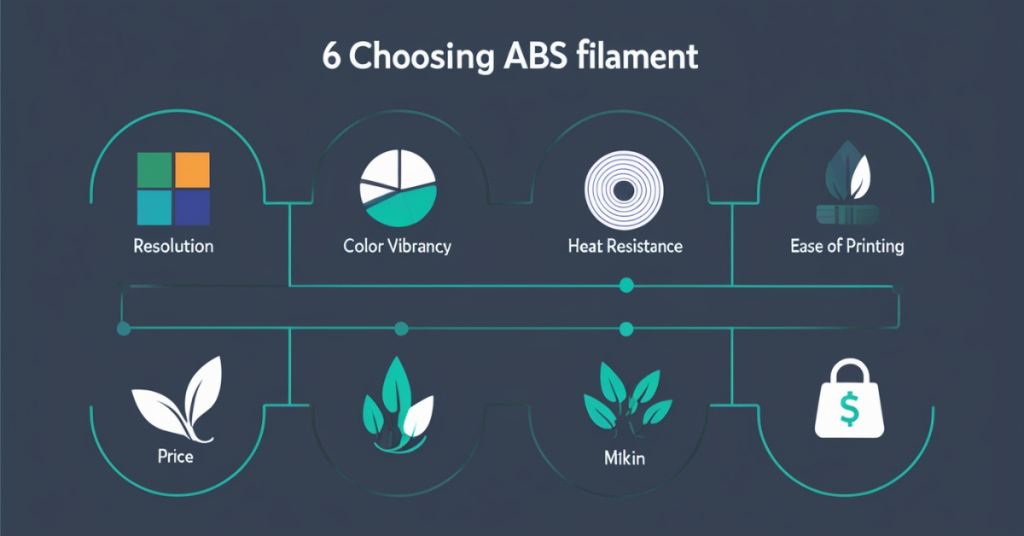
Selecting the perfect ABS filament is a bit like matchmaking. You’re not just looking for any roll; you’re searching for ‘The One’ that aligns with your specific needs. So, how do you find your filament soulmate? Consider the following:
Print Resolution & Surface Quality
- What’s the fuss?: Some ABS filaments offer incredible details, producing prints that make every tiny feature pop.
- Tip: If you’re into miniatures or crafting intricate jewelry, pick an ABS roll known for its high resolution.
Color Vibrancy & Rang
- What’s the fuss?: A broader color range gives your creativity more room to play.
- Tip: If you’re into artsy projects or want a splash of color, explore rolls that offer diverse or unique shades.
Heat Resistance & Stability
- What’s the fuss?: Not all ABS is created equal. Some can handle higher temperatures without warping.
- Tip: If you’re creating parts for heated environments (like car interiors), invest in ABS with enhanced heat resistance.
Price & Value for Money
- What’s the fuss?: We all love a bargain, but it’s essential to balance cost with quality.
- Tip: Determine your budget but be willing to stretch a bit if it means getting significantly better quality.
Environmental Impact
- What’s the fuss?: The green movement is real, and some ABS filaments are more eco-friendly than others.
- Tip: If being kind to Mother Earth is your thing, look for brands promoting sustainable practices or biodegradable options.
Ease of Printing
- What’s the fuss?: Some ABS rolls are easier to print with, minimizing issues like warping or bed adhesion.
- Tip: Especially if you’re a beginner, it might be wise to start with filaments known for their user-friendliness.
Post-Processing Options
- What’s the fuss?: After printing, you might want to smooth, paint, or modify your creation.
- Tip: ABS that responds well to acetone smoothing or can be easily painted can open doors to more sophisticated finishes.
Brand Reputation & Reviews
- What’s the fuss?: Established brands often provide consistent quality, but newer brands might offer innovative features.
- Tip: Dive into user reviews. Real-world feedback can be a goldmine of insights.
Remember, it’s all about finding the ABS roll that harmonizes with your project’s nature and your personal preferences. It’s a journey of discovery, and armed with these considerations, you’re well on your way to making an informed choice. Ready to embark on this filament-finding adventure? 🌍🔍🎉
Conclusion
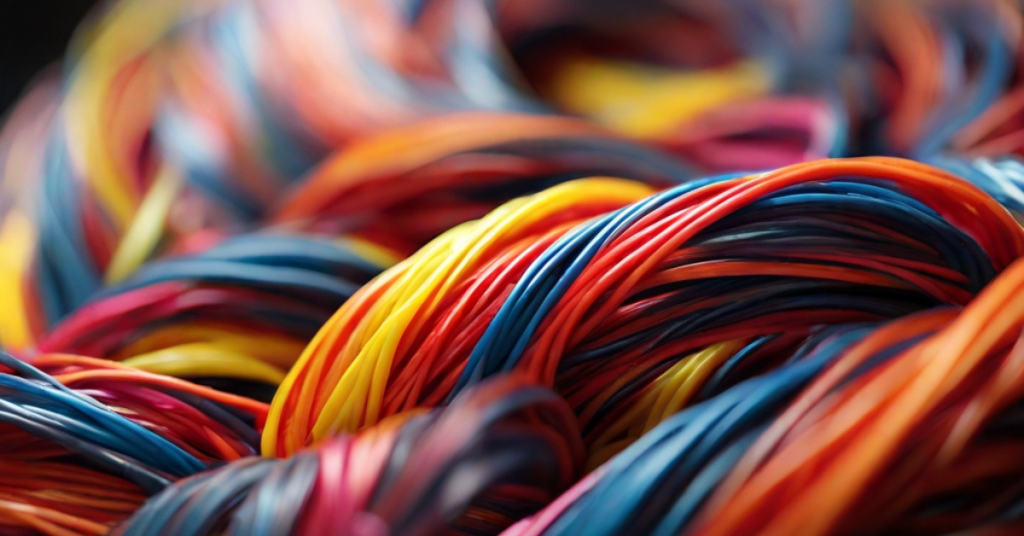
And there you have it! The crème de la crème of ABS plastic rolls for 3D printers in 2024. Whether you’re a hobbyist or a pro, there’s an ABS roll out there waiting to transform your 3D printing dreams into reality. Ready to take your projects to the next level? 🚀
FAQs
- Why is ABS preferred over PLA for certain projects?
ABS generally offers better strength and durability compared to PLA, making it ideal for functional parts. - Is ABS safe for children’s toys?
Yes, but ensure the toy is properly printed with no sharp edges or small parts that can be swallowed. - How should I store my ABS rolls?
In a cool, dry place. Moisture can affect the quality of your prints. - Can I paint over ABS prints?
Absolutely! Just make sure to use a primer first. - Why is my ABS print warping?
Warping can occur due to uneven cooling. Ensure your print bed is heated and consider using an enclosure.
Hope you found this guide helpful! Remember, the right tools (and filaments) can make all the difference in your 3D printing journey. Happy printing! 🖨️🎉

